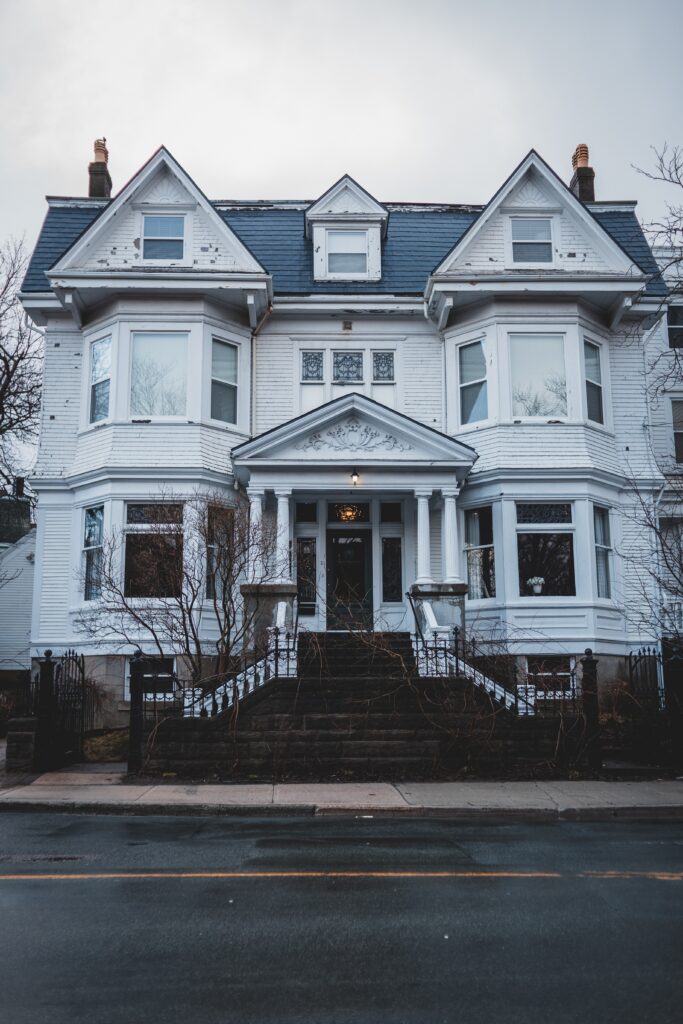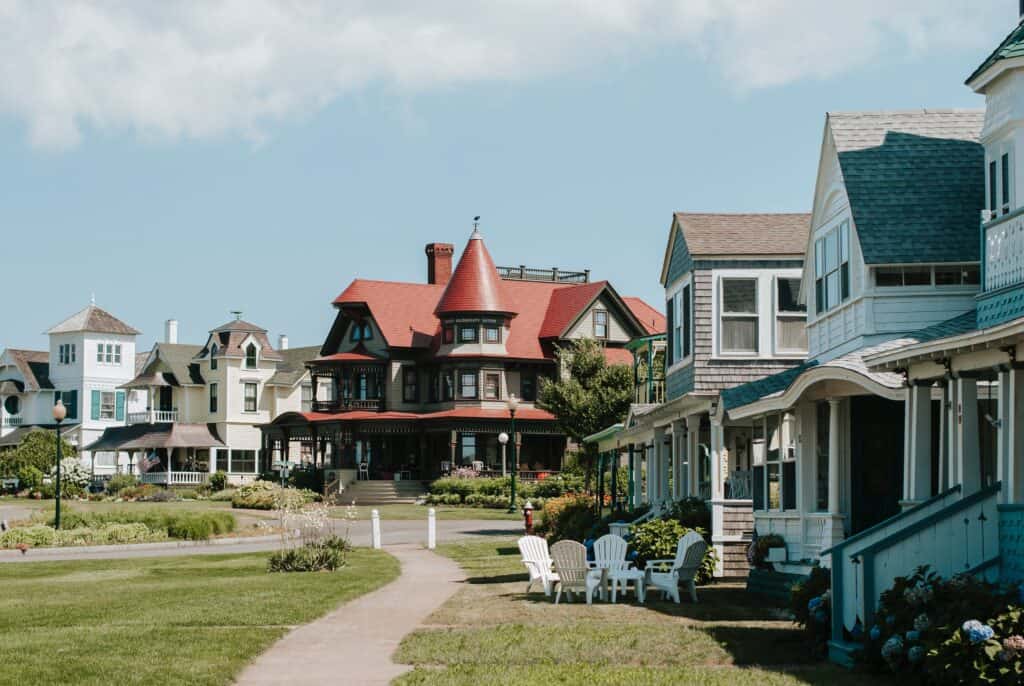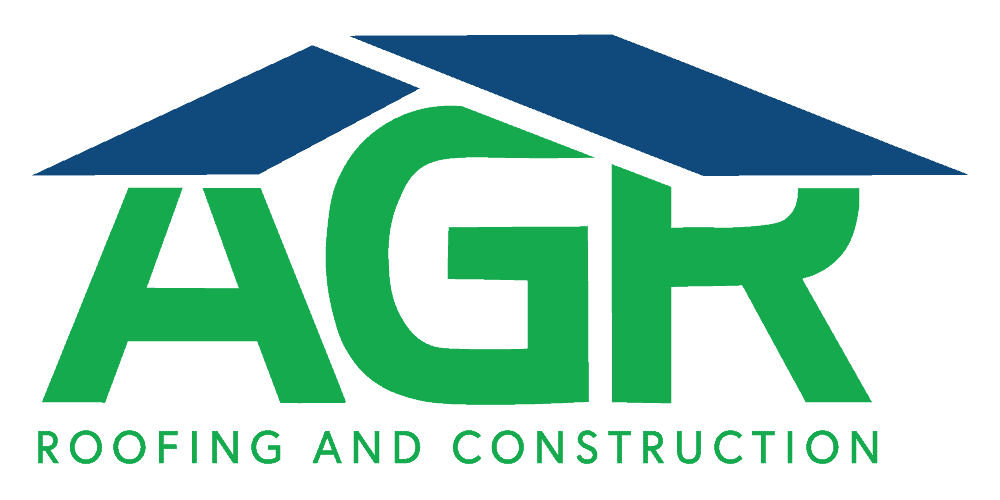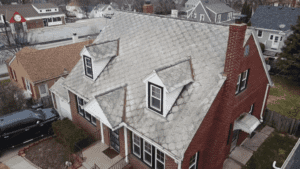When an older home needs a new roof, there are so many charming features and intricate details that can look out of place. It is essential to ensure that the materials you select for your new roof and the roofing contractor you choose can meet the requirements and aesthetics of your historic home.
If you are in charge of a historic or period-style home, the Des Moines roofing company you hire needs to pay close attention to the roof’s structure, roofing materials, and design style.
The common roofing types and materials used in various American eras, all of which are still readily available today, are shown below. You can see examples of all these styles and roofing materials throughout Nebraska and Iowa.

Roofing for Older Homes
The majority of historic homes had natural materials for their roofs that were easily accessible. Wood shingles, clay tiles, and stone tiles were some of the earliest roofing materials used. Roofing materials that required more labor or manufacturing were used as industries and the economy grew. Metal and asphalt were frequently used in later historical eras. The good news is that, with the exception of asbestos tile, the same materials used to construct older homes are still readily available.
Historic Roof Materials:
Slate Roofs
Slate roofing was used as early as the 17th century, though it wasn’t very common because of the price. Slate began to become a little more common when it was brought to America from Wales in the 18th century. Slate became more widely available as slate quarries grew throughout the east in the middle of the 19th century. Slate of all colors was used at that time, frequently in geometric patterns.
Slate tiles are still readily available today, but most homeowners who prefer this look choose composite materials that resemble slate tiles. These modern materials are stronger and lighter than conventional slate roofs.
Cedar Shake Shingles
Natural wood shingles were among the first roofing materials used in America. Traditional wood roofing materials include split shakes, cut and dressed shingles, smooth sawn shingles, and smooth sawn lumber.
Sawn-smooth or cut-and-dressed shingles were used on houses constructed after the colonial era. In the 20th century, split-shake shingles were developed. Bent shingles are a common feature of Arts & Crafts-style homes.
The types of wood used would depend on what was readily available in the area. The northeast used pine as a common building material, the west used redwood and cedar, and the south used oak and cypress.

Clay or Ceramic Tiling
Clay tiles were first used in Jamestown in the middle of the eighteenth century, followed by New York, Boston, and all of Pennsylvania. However, the majority of these were used in Spanish colonies. Clay tiling is popular in Spanish colonial and Mission architectural styles. Spanish colonial clay tiles were typically barrel-shaped, as opposed to the flat and plain tiles used in other architectural styles. Colored glaze was used in a few of these other architectural styles, such as those used on Beaux-Arts buildings.
Although composite roofing shingles that resemble real wood but don’t pose the same fire risks are also available today, cedar shake roofs are still popular. Real cedar shake shingles are less durable than synthetic cedar shake shingles.
Asphalt Shingle Roofs
Asphalt was created in the middle of the 19th century and was offered for sale as rolls or shingles. Back then, self-locking hexagonal or diamond patterns were common in asphalt roofing products.
Even today, asphalt shingle roofs are the most common choice for residential roofs. They are reasonably priced, have a 20-year lifespan, and come in a variety of colors and styles.
Metal Roofs
Iron, tin, and copper were used as roofing materials starting in the 19th century. These metals, which are typically sold in sheets, can also be lead- or zinc-coated. Metal roofs with seams are found on some of America’s most recognizable old structures.
Metal roofs are still very popular today and can restore the original appearance of a classic carriage house, farm house, or barn.
Traditional Roof Design History
There have been many different housing trends in America. Here is a list of some of the more well-known historical architectural styles, as well as some guidance on significant roofing characteristics.
1600s Roofs and Historic Homes
Saltbox homes have steep pitched roofs with a back slope that slopes down to the ground level. Saltboxes were common in New England due to how easily snow and ice slide off the steep slope. Wood shingles typically make up saltbox roofs.
British Colonial homes have medium-pitch side gable roofs with twin chimneys in the middle.
Curved eaves and wood shingle gambrel roofs are characteristics of Dutch Colonial homes. The primary locations for this particular housing type were the Dutch colonies in New York, New Jersey, Delaware, and Connecticut.
1700s Roof Styles
Dormer windows and symmetrical hipped roofs are features of traditional wood-shingled Georgian homes from the 1700s.
Federal homes frequently have square or rectangular hipped roofs made of metal, slate, or wood shingles. This style, which was popular between 1780 and 1830, was influenced by classical antiquity and Rome. It resembles Georgian architecture somewhat, despite being less ornate.
1800s Roof Materials and Designs
Greek Revival architecture, which was popular in the 1800s, is characterized by symmetrical façades, low-pitched gable roofs, and sporadically transoms or dormer windows.
The Gothic Revival architectural style is characterized by steep cross gables, steeply pitched roofs, and elaborate vergeboards, arches, extended windows, dormers, and other ornaments.
Italianate homes frequently have flat, mansard, or hipped, low-pitched roofs with cupolas. These roofs may be embellished with extending eaves on ornamental brackets, cornices, corbels, pediments, and panel moldings. Italianate roofs are best constructed with metal.
Second Empire houses typically have four-sided gambrel, mansard, or dual-pitched hipped roofs, numerous dormer windows, an iron crest, bracketed eaves, balustrades, and patterned shingles.
Stick style homes became popular as a gothic to queen anne transitional style. The roofs are steep, angular, and intricate, with intersecting gables, clips, hoods, eaves, and towers.
Towers, turrets, gables, and dormers are just a few of the designs and features found on the steep-pitched roofs of Queen Anne homes. Slate and cedar make for good historically accurate roofing materials.
1900s Homes’ Roofs
Early 1900s shingle-style homes feature gambrel or hipped roofs that are enhanced by dormers and come in a variety of shapes to accommodate complex floor plans. These roofs are typically made of thick wood shake shingles.
Colonial Revival homes occasionally have hipped or gambrel roofs, though they typically have straightforward gable roofs. Porticos, large dormer windows, moldings, and other details can be added to the roofs to decorate them. Up until World War II, slate shingles were used on roofs of colonial revival architecture.
Romanesque square masses with distinct hip roofs and hipped roofs with lower cross gables are characteristics of Richardsonian architecture. Towers with roon or polygonal shapes cover the roof.
Compared to traditional Victorian homes, folk Victorian homes have simpler gabled roofs, dormers, and roof trimming.
Neoclassical homes typically have symmetrical hipped roofs, triangular pediments, big domes, dormers, and few other decorative elements.
Services for Roofing on Historic Homes can seem scary, but hiring the right roofing company in Omaha can take care of the uncertainties. The first step in replacing the roof on an older home is to get a roof inspection from a local roofing company.





